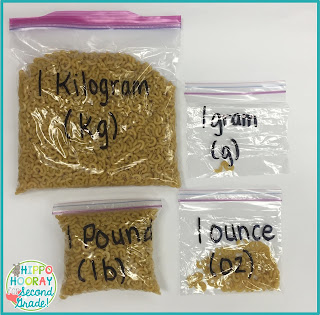One of our third grade Common Core math standards asks students to estimate and measure the masses of objects. Our kiddos have a hard time relating to weight, and now we have to teach mass?
What Exactly is Mass?!
Mass is how much matter is in an object. Mass never changes, where weight can change depending on how much gravity there is. This distinction is a little high-level for our third graders, so I just say "how much stuff is inside an object." We typically use grams and kilograms to measure mass. Here are some of strategies I use to help my students understand this tricky concept.My goal when teaching my students to measure and estimate mass is to give them as many experiences as I can with different masses and helping them to connect each measurement to everyday objects. I actually teach this concept during my science time, as mass is typically associated with science. My kiddos love to be "real scientists" who measure in grams and kilograms!
Fist I start with these bags. I filled each bag with macaroni noodles for each unit. When I first did this three years ago, I used rice instead of noodles. Rice is a lot harder to clean up if it spills. Not like I have experience with that....
It might be hard to see, but there are just three macaroni noodles in the gram bag. That bag always gets many surprised looks from my students! I pass the bags around the circle, so my students can physically feel how heavy each unit is. They also like holding two bags at the same time to compare them.
 |
| Here we are discovering that a paperclip weighs about 1 g. |
After they have an understanding of different masses, we then practice estimating and then finding the actual measures. This is the sheet we use for this experiment. I always have my students write all of their estimates with a marker or a pen. That way, they can't erase them when they realize their estimates are WAY off :)
If you're interested in either of these activities, you can download the freebie HERE.
Estimating mass is SO hard, but with lots of practice, our third graders will get better at it. What are some tips and tricks you use to help your students understand mass? Let me know in the comments!






We are beginning our unit on measuring mass tomorrow. I am so excited I use this as a kickoff activity.
ReplyDeleteWhat great timing! I'm so glad you found this helpful!
DeleteWe don't use CCSS for math (we do for Language Arts though...) so we don't have a mass standard. Our curriculum discusses it a bit, but not much in depth to really carry any meaning to my students. I'll definitely come on back to this towards the end of the year when we have a bit of extra flexibility as this looks super engaging (not to mention important!) Thanks so much for the awesome freebies!
ReplyDeleteThat's interesting that you use ELA but not math. I actually taught most of this during my science time, so you could always squeeze it in there if you have extra time :)
DeleteA few questions about how you managed the macaroni. Did you make enough for each group to have one bag of each size? Did you have extra 1 gram bags for objects that weighed more than 1 gram? Were the bags an eye-ball measure or did you do something to precisely measure each bag. Thank you! I'm a 4th grade teacher in TN and teaching mass is one of our science standards. I'm excited to use this activity this year!
ReplyDeleteI'm sorry I didn't reply sooner; I'm just seeing this! We made one bag of each size as a whole class. I used a pan balance for the smaller amounts and a food scale for the larger amounts. Hope that helps!
Delete